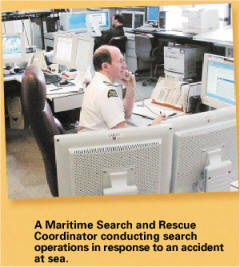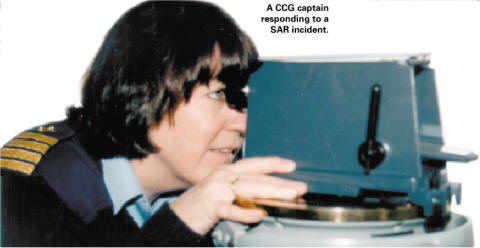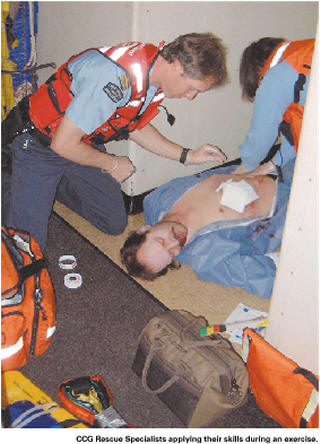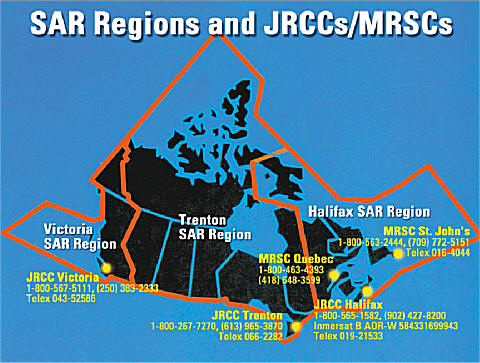Canadian Coast Guard
Search and RescueALERTING, DETECTION & RESPONSE
Dealing with accidents at sea
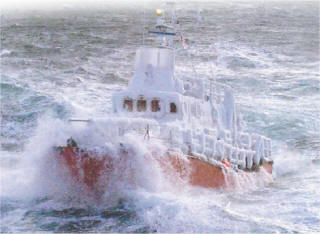
Download the document in [pdf 6.4 MB]
Safety information for small vessel fish harvesters
Introduction
Fishing can be a dangerous activity that involves an extremely high level of risk. While Canadian fish harvesters are encouraged to achieve safety through preventative actions, there are times when additional measures are necessary. When an accident occurs, the Search and Rescue (SAR) system quickly becomes the primary safety net.
When dealing with emergencies, fish harvesters should understand three important components of the SAR system: alerting, detection and response.

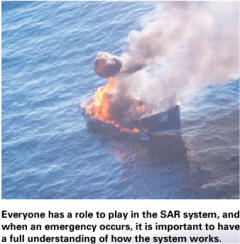
Alerting
The alerting stage represents a significant level of urgency for SAR providers and carries with it a well-structured course of action(s) designed to bring a marine incident to a successful conclusion. Fish harvesters should be aware of the key elements of the SAR alerting system and know how to activate it for a quick response:
- the Department of National Defence (DND) and Fisheries and Oceans Canada
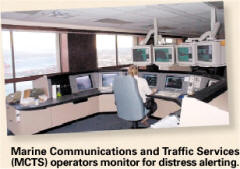
(DFO – Canadian Coast Guard (CCG) operate three Joint Rescue Coordination Centres (JRCCs) and two Maritime Rescue Sub-Centres (MRSCs) that provide search and rescue operations 24 hours a day, 365 days of the year in support of maritime activity in Canadian waters;
- international SAR agreements and conventions ensure a SAR alerting infrastructure is available for all mariners worldwide;
- fish harvesters who use the telephone system (terrestrial or satellite) for any type of alerting, should have telephone numbers of JRCC/MRSCs for their area conveniently posted for easy access in case of emergencies;
- a network of Marine Communications & Traffic Services (MCTS) centres operated by the CCG monitors for distress alerting and provides a communications link between emergencies at sea and the JRCC/MRSCs;
- MCTS centres provide a radio station listening watch on very high frequency (VHF) channel 16 (156.8 MHz) and medium frequency (MF) 2182 kHz, 24 hours a day, 365 days a year;
- MCTS centres provide mariners with important safety services, including medical advice, weather updates, ice information, Notices to Shipping and other information that can be critical in preventing marine incidents and resolving marine emergencies;
- as part of the Global Maritime Distress and Safety System (GMDSS) a VHF Digital Selective Calling (DSC) service on VHF channel 70 has been fully operational since August 1, 2003 and monitoring for VHF/DSC distress alerting is maintained at Canadian MCTS centres where A1 Sea Areas apply. Commencing August 1, 2006, the monitoring for VHF/DSC distress alerting became available in the St. Lawrence and Great Lakes zones, even through these zones are not part of the A1 Sea Areas;
- the Canadian Coast Guard wishes to remind operators of the importance to register new VHF/DSC radio equipment and to inform Industry Canada of all modifications concerning the related coordinates when registering VHF/DSC radio equipment;
- as part of the GMDSS requirement for Sea Area A4, in Canadian Arctic waters above 70 degrees North latitude, a High Frequency Digital Selective Calling (HF/DSC) service is available at the Iqualuit MCTS Centre. This service provides continuous HF/DSC alerting, voice communications and narrow-band direct printing broadcasting capabilities on a number of selected frequencies in the 4,6,8, 12 and 16 MHz radio band. Fish harvesters operating in the Canadian Arctic should consult the Fisheries and Oceans Canada (DFO) annual publication Radio Aids to Marine Navigation (RAMN);
- additional MCTS services, including radar monitoring, are available in selected areas where Vessel Traffic Services (VTS) zones are established. In these areas, communications are maintained on designated VHF sector frequences specific to each area where VTS zones are located; and,
- Star (*) 16 exists through the cellular telephone system at certain MCTS centres in Canada for Maritime SAR alerting only. Where this feature is not provided by the local cellular telephone company, the SAR system can be reached using a cellular phone by dialing directly to JRCC/MRSC or the MCTS centre in the area of operation.
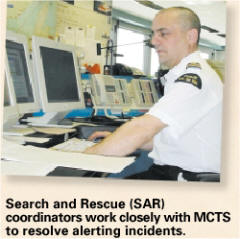
Mariners are cautioned that a cellular telephone is not a good substitute for a marine radio because the mobile radio safety system in the southern waters of Canada is based principally on VHF, radio/telephone (R/T) and DSC communications. VHF has the advantage that a call can be heard by the closest MCTS centre(s) and by ships in the vicinity which could provide immediate assistance. On the other hand, the cellular telephone network is a party-to-party system and the benefit of the broadcast mode in an emergency situation is not available. Details of this service may be obtained by contacting local cellular telephone companies, however, mariners are cautioned that not all cellular telephone companies provide this service.
Information on the locations, points of contact, marine services, coverage areas and procedures provided by MCTS centres in Canada can be found in the RAMN annual publication. Fish harvesters are cautioned that while VHF coverage exists in southern Canadian waters with a theoretical range of 40 nautical miles (N/M) from the coast, they should consult the RAMN annual publication for areas in some northern latitudes and the Canadian Arctic where VHF coverage does not exist.
Communication
Communication is the principal means for alerting the SAR system. For this reason it is important for fish harvesters to have, and understand, equipment on board their vessels that is compatible with the systems that are available in the SAR network. The following standards and procedures should apply onboard all vessels:
- VHF and MF transceivers and their antennas, when carried, should be properly installed according to manufacturers' instructions, with special attention given to protection from the elements;
- a continuous listening watch must be maintained on VHF channel 16 when underway, or on a designated frequency when operating in a traffic system;
- procedures associated with GMDSS requirements relating to HF and VHF/DSC will prevail when operating in Sea Area A4 and when Sea Area A1 is declared fully operational on August 1, 2003;
- a continuous listening watch should be maintained on MF 2182 kHz, if carried;
- an understanding of the procedures associated with standard radio priorities of safety, urgency and distress as contained in the annual RAMN publication, section 4-4 to 4-7;
- when issuing any type of alert include the following information:
- name of vessel or person (cellular number if used) initiating the call
- position of incident
- nature of incident
- number of people on board
- type of assistance required
- any other information deemed essential to a safe resolution of the situation;
- alerting about the emergency should occur as early as possible; and,
- emergency situations should be treated with a high degree of urgency and downgraded only when the situation warrants.
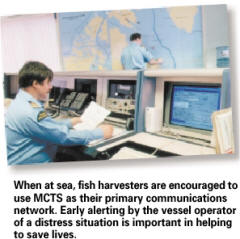
While all means of communication are encouraged for SAR alerting, a marine radio offers a distinct advantage. The mobile radio safety system in southern Canadian waters is based primarily on VHF, R/T and DSC communications. VHF and/or other R/T communications have the advantage of being monitored by other stations or ships in the immediate vicinity. It is also very important that at least one person has the appropriate training in the operations of the communications equipment in use onboard the vessel. In addition, knowing your equipment and the capacity of the shore stations and vessels in your vicinity to monitor communications is extremely important.
Global Maritime Distress and Safety Systems (GMDSS)
Conventional or traditional communications are currently undergoing significant change. Conventional types of communication using basic terrestrial technology are being supplemented by space technology. Satellite technology and DSC provide features and options for SAR alerting that increases both efficiency and certainty of reception ashore. The system, known as Global Maritime Distress and Safety System (GMDSS) is designed to:
- increase the efficiency and likelihood that an alert will be sent when a vessel is in distress;
- increase the likelihood that the alert will be received;
- improve the ability to locate survivors;
- improve rescue communications and coordination; and,
- provide mariners with vital maritime safety information.
GMDSS is an international system that began in 1992. In keeping with the international GMDSS standard, Canada is implementing a system of domestic carriage requirements for commercial vessels. These carriage requirements are defined by regulations under the Canada Shipping Act and depend on the size and location in which vessels operate.
Sea Areas
A worldwide system of Sea Areas has been defined under GMDSS. These include:
- Sea Area A1 - within range of shore-based VHF/DSC coast station transmitter sites (40 nautical miles);
- Sea Area A2 - within range of shore-based MF/DSC coast station transmitter sites (40 - 150 nautical miles);
- Sea Area A3 - within range of an Inmarsat goestationary satellite (approximately 70 degrees North latitude to 70 degrees South latitude - excluding Sea Area A1 and A2); and,
- Sea Area A4 - the remaining areas outside of Sea Areas A1, A2 and A3, generally known as the Polar Regions.
Canada has implemented all Sea Areas except Sea Area A2. This means that fish harvesters operating outside of VHF coverage on the coast (theoretical range of 40 N/M) need to carry onboard their vessel GMDSS equipment that conforms with Sea Area A3. Canada has made modifications to the GMDSS carriage requirements for domestic users such as fishing vessels of certain sizes. While fishing vessels operating in Sea Area A3 can supplement their equipment with Inmarsat C distress alerting capabilities, it is not mandatory unless the vessel is greater than 300 Gross Registered Tons (GRT). Fish harvesters should consult with a Transport Canada (TC) marine safety inspector (marine safety surveyor)to ensure they are carrying the GMDSS equipment for the area in which they are operating.
Digital Selective Calling (DSC)
In keeping with international and domestic equipment required onboard vessels, MCTS centres are currently upgrading their equipment to accommodate SAR alerting through the GMDSS using DSC technology. HF/DSC alerting services has already been established for Sea Area A4 (Canadian Arctic above 70 degrees north latitude). Effective February 1, 2003, MCTS VHF/DSC was placed in “Initial Operational Condition” (IOC). Sea Area A1 will be officially declared in Canadian coastal areas when MCTS VHF/DSC meets its “Full Operational Condition” (FOC) scheduled for August 1, 2003. Fish harvesters should be aware of the following:
- fishing vessels eight metres in length or greater and of closed construction operating in a Sea Area A1 are required to be fitted, effective August 2003 with a VHF transceiver capable of DSC and automatic distress alerting on channel 70;
- it is essential for alerting and other communication purposes that a DSC radio is programmed with a valid Maritime Mobile Service Identification (MMSI) number. These numbers are issued free of charge by Industry Canada district offices;
- VHF transceivers with DSC capabilities should be connected to a navigational receiver such as a Global Positioning System (GPS) in order to automatically transmit the vessel's position simultaneously with a distress alert;
- once DSC has made contact on VHF channel 70, DSC equipment normally switches automatically to channel 16 where follow-on voice communication takes place;
- automatic switching may cause problems during critical operations within a VHF sector listening watch area of a VTS zone. Should this situation arise, fish harvesters are cautioned to temporarily discontinue the DSC feature until their required operation is completed;
- fish harvesters who are monitoring a specific VHF channel, in accordance with VTS requirements, should return the radio to the proper sector frequency after determining the nature of the DSC alert broadcast on channel 16;
- fishing vessels operating in waters beyond Canadian jurisdiction may have their communications equipment supplemented with R/T MF capable of DSC and automatic distress alerting on 2187.5 kHz. Since their primary means of alerting when transiting Canadian waters;
- fish harvesters who accidentally transmit a distress/urgency/safety broadcast on DSC must cancel the broadcast immediately in order to avoid unnecessary activation of the SAR system;
- GMDSS compliant vessels are no longer required to maintain a listening watch on MF 2182 kHz.;
- GMDSS compliant vessels are required to continue maintaining a listening watch on VHF channel 16 in order to communicate with vessels that have not yet up-graded to VHF/DSC radio; and,
- to help ease the transition to the GMDSS and bridge the communications gap between R/T and DSC, MCTS centres will continue to monitor the current distress and safety channels (VHF channel 16 and MF 2182 kHz) for the foreseeable future.
There is currently no Sea Area A1 in the St. Lawrence River system west of Longitude 66 degrees West, the Great Lakes and other inland waterways. Upgrading to accommodate DSC distress alerting is planned in conjunction with the United States system in the near future. Fish harvesters operating in the absence of MCTS VHF/DSC alerting services can expect current standard VHF radio services to prevail. Fish harvesters upgrading their shipboard communications equipment in these areas are recommended to equip their vessels with the DSC option for bridge to bridge distress alerting.
Emergency Position Indicating Radio Beacon (EPIRB) Distress Alerting
One of the most important impacts of GMDSS is the use of Emergency Position Indicating Radio Beacon (EPIRB) for distress alerting. GMDSS makes use of the COSPAS/SARSAT Satellite System (Search and Rescue Satellite System) to provide global detection of the 406 MHz EPIRBs. These coded beacons are small, portable, buoyant, and provide an effective means of issuing a distress alert anywhere in the world. Any signal received from an EPIRB is considered to be a positive indication of distress. EPIRBs are not currently mandatory for some smaller fishing vessels but it is highly recommended that all fish harvesters carry them onboard.

Things to be aware of when fitting fishing vessels with EPIRBs:
- fishing vessels eight metres or more in length that go beyond 20 N/M from shore must be fitted with a 406 MHz EPIRB as of April 1, 2002;
- EPIRBs are not required to be float-free if the vessel is less than 15 GRT;
- EPIRBs may be float-free and automatically activated with a manual activation option (Class 1) or manually activated only (Class 2). The carriage of float-free EPIRBs is highly recommended regardless of the size or location of the vessel;
- EPIRBs must be registered in the National SAR Secretariat's 406 MHz beacon registry by calling 1-800-727-9414. There is no cost for this service; and
- EPIRBs must be installed and tested immediately, and checked every six months according to manufacturers standards and/or recommendations.
Class l EPIRBs are housed in a special bracket equipped with a hydrostatic release. This mechanism releases the EPIRB in water depths of one to three metres (three to ten feet)at which time the EPIRB floats to the surface and begins transmitting. It is therefore important to have float-free EPIRBs fitted onboard in an area where obstructions will not prevent their release or ability to float free. Since Class II EPIRBs are manually activated only, it is important that they are fitted in a location where they are most readily available in the event of an emergency.
Other GMDSS Alerting Equipment
There are other types of alerting equipment available under the GMDSS that are used regularly on vessels operating further offshore. The Inmarsat satellite network provides global communications except for Polar Regions. In areas without any VHF or DSC shore facilities, Inmarsat A, B or C terminals are used for distress alerting and communications between ship and shore. Inmarsat provides an efficient means of routing distress alerts to SAR authorities ashore.
Fish harvesters should be aware that Maritime Safety Information (MSI) comprises of distress alerts, SAR information, navigational and weather warnings, which can be received by the following methods:
- Inmarsat C terminals, which offer two-way communications including automatic distress alerting, also receive Enhanced Group Call-Safetynet (EGC) broadcast for areas outside NAVTEX coverage; and,
- NAVTEX receivers, which offer one-way communication from shore-based facilities operated by the CCG MCTS centres, are fully automated and receive broadcasts in coastal regions up to 300 N/M offshore (annual RAMN publication should be consulted for services and coverage areas).
Currently in Canada, 518kHz is used for both English and French language NAVTEX broadcasts, however as of January 1, 2005 NAVTEX broadcasts by CCG MCTS centres wil be on 518kHz for English language broadcasts and 490kHz for French language broadcasts in designated waters. Fish harvesters should consult the most recent RAMN publication for new information pertaining to GMDSS. When required, this publication is revised on a monthly basis through Notices to Mariners Part III.
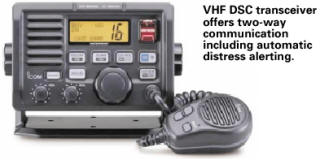
Other Alerting Systems
Technology, in particular, has provided tools for alerting in many different forms. There is versatile communications equipment available through both satellite and cellular service. Satellite technology has seen the development of various tracking methods and alerting devices such as Personal Locator Transmitters (PLTs) or customised Man Overboard Tags (MOTs). As systems, such as fish management tracking/monitoring devices, are developed and become more standardized it will be easier for SAR to incorporate them into a more elaborate alerting regime. Fish harvesters should use caution when using any alerting system that is not compatible with or approved to current SAR requirements. If such systems are used, fish harvesters should understand their limitations and know how to apply them to get the necessary safety benefits.
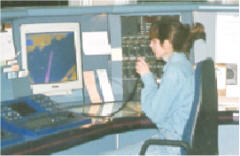
Operator Proficiency Training
Training and experience are essential when operating communications equipment during an emergency. Training is especially important in light of the new GMDSS requirements. The following courses are required/recommended and offered on behalf of Industry Canada (IC):
- General Operators Certificate (GOC) is a 10 day course offered by marine training institutions and is required on most compulsory fitted GMDSS vessels operating outside Sea Area A1;
- Restricted Operator Certificate - Marine Commercial (ROC-MC) is a three day course offered by marine institutions for operators of compulsory fitted GMDSS vessels operating in Sea Area A1 (pre-requisite for GOC). This certificate, which can be shortened to one or two days and may also be obtained through a challenge exam if personal knowledge level permits, is also recommended for operators of GMDSS equipment on voluntary fitted vessels; and,
- Restricted Operator Certificate - Marine (ROC-M) is a basic certificate offered by the Canadian Sail and Power Squadron (1 888-277-2628) or their delegated agency for operators of non-compulsory fitted vessels (e.g. small inshore fishing vessels and pleasure craft operators). This certificate can be completed by self-study or with instruction. A challenge exam can also be completed depending on the level of knowledge of the operator.
Fish harvesters should be aware that if they choose the option of a challenge exam for any GMDSS training certificate, a practical component involving the operation of equipment is a part of the evaluation. In order to properly assess the most appropriate training available, it is recommended to contact marine training institutions or a TC–marine safety inspector for information and advice.
Visual Distress Alerting
There are various methods of visual alerting described in the Collision Regulations (Canada Shipping Act) and fishing vessels should be equipped accordingly. These may be the only means of signalling for assistance during times of emergencies. Other times, they can serve as a supplement to other alerting methods.
In many instances visual alerting is the easiest and quickest way to get the necessary help. Fish harvesters often fish within a close distance to one another therefore a visually activated signal will, in many cases, be seen and acted upon quickly.
In order to be prepared for visual alerting, it is necessary to understand the importance of flares and what type you should carry onboard:
- every fishing vessel exceeding 15 gross tons is required to carry:
- 12 type C (hand held) flares and one of the following, either;
- six type B (rocket multi-star) flares if operating not more than 20 nautical miles from shore, or
- six type A (parachute) flares if operating more than 20 nautical miles from shore;
- every fishing vessel not exceeding 15 gross tons is required to carry one watertight can containing six approved self-igniting flares and,
- the canister activated smoke signal (type D) is a common flare used during daylight hours. Even though this flare is not mandatory for all fishing vessels, the voluntary carriage of these canisters is recommended.
While these requirements represent the minimum standard, you are encouraged to supplement signalling equipment. All flares should be stored in a watertight container and kept in a cool, dry place. Flares are approved by TC. This approval is only valid for four years from the date of manufacture. Following this, flares should be replaced and the outdated units disposed of in an approved manner. Any questions or concerns should be directed to TC-Marine Safety, CCG Office of Boating Safety, local fire department or police authority.
Other standard marine distress signals are described in the Collision Regulations.

Other Alert Safety Nets
The SAR system reaches far and wide and includes police, harbour and municipal authorities, federal and provincial agencies as well as other secondary support groups. The process of SAR alerting does not necessarily have to begin and end with the formal SAR network.
The role of the user is perhaps the most critical of all in activating the system. Early or timely notification, and accurate and descriptive information are key components. Second party involvement can also be important for SAR alerting. Either a designated person or organization can activate the system on behalf of another person, especially in overdue situations.
Fish harvesters should consider the following when dealing with second party alerting:
- filing a formal sail plan with a responsible individual, company or MCTS centre;
- developing a buddy system with other fish harvesters;
- proactive involvement of family members; and,
- instituting a plan with community organizations such as boating clubs, agents or fish plants.
Failing to report changes in plans or delays in arrival times or failure to cancel the plan after arrival can unnecessarily activate the SAR system. This could cause an unnecessary search at the expense of other emergencies occurring elsewhere at the same time.
Alert Planning
Detailed and accurate information is important in every situation involving an alert. Schedules, timelines, destinations, routes, gear locations, reporting procedures, people-on-board and medical considerations should be left with a responsible person and available in the event of a SAR alert. Information, such as vessel characteristics (length, colour and construction material), fuel, food supplies and survival equipment onboard are important details that should be properly documented.
Time should not be lost in reporting any situation that may warrant SAR attention. Early intervention is one of the most effective tools available to SAR providers in achieving a successful outcome.
False Alerts
Accidental or inappropriate distress alerts seriously distract from the efficiency of GMDSS or any other systems in use. False alerts can seriously create an unnecessary workload for SAR services and put lives in danger by causing the unnecessary deployment of resources. Fish harvesters are cautioned to take the necessary steps to properly notify the SAR system of such occurrences. The annual RAMN publication, section 4-32 provides instructions on the processes available for cancelling false alarms. Knowingly activating a false alert is an offence under the Criminal Code of Canada.
Detection
Communications Equipment
Detection is an element of response. It can sometimes be accomplished with the same tools used for alerting. Being fully fitted with communications equipment provides one of the most important means of alerting. At the same time, the equipment can also be used in a response situation to locate your vessel. Homing equipment available on most SAR resources and shore-based facilities will detect communications equipment onboard a vessel.
Fish harvesters, including those operating in small inshore open or closed boats must consider the importance of fitting their vessel with VHF, R/T, a mobile telephone and/or other communications equipment.

Direction Finding (DF)
Some MCTS centres across Canada are equipped with Direction Finding (DF) capabilities. The primary function of DF is to provide assistance to vessels in distress or other emergency situations. Fish harvesters should be aware that this is not a navigation service, but rather an aid for detecting location by providing a line of bearing from the DF site. It can also confirm a line of bearing for vessels that are uncertain of their location. MCTS centres will, on request, transmit signals on a frequency that will enable fish harvesters to take a bearing from their own DF.
Fish harvesters using this service must use discretion and be aware of its limitations. Positions must be regarded as estimates only. Bearings from shipboard DFs may be affected by atmospheric and calibration anomalies and placement of metallic objects (poles, wires, winches, antennas, etc.). The locations of MCTS centres with DF facilities are listed in the RAMN publication. Fish harvesters should consult this publication for locations and other information relating to the use of DF equipment.

EPIRBs
EPIRBs can serve a dual function of alerting and detection. Once an EPIRB is activated (automatically or manually), the battery-powered source allows the EPIRB to continue to transmit for up to 48 hours. An interface feature with a built-in GPS system on new generation EPIRBs provides an automatic fixing in latitude and longitude. With or without this feature, there is a continuous transmission of coded signals that allows the SARSAT system to fix positions and obtain information through the unique identification number. A properly registered EPIRB will assist SAR in identifying the vessel and owner.
All 406 MHz EPIRBs have a built-in transmitting feature on 121.5 MHz that will direct SAR resources to your location when they are in the area. EPIRBs must be maintained and properly used to provide the protection for which they were designed. Aside from the procedures and standards outlined in the alerting section, you should consider the following in the interest of detection:
- when activated, EPIRBs immediately alert SAR authorities ashore. Care must be taken to avoid accidental activation;
- a class I EPIRB should be installed in a place where it will float-free unobstructed and with the switch in the automatic mode;
- a class II EPIRB should be installed in a location where it can be quickly and easily accessed for manual use and transport; and,
- when abandoning ship, EPIRBs should be taken to the survival craft to continue transmitting.
Search and Rescue Radar Transponder (SART)
Search and Rescue Transponders (SARTs) are designed to help locate vessels in distress or survivors in a life raft. They can be detected by radars carried onboard most vessels. SAR and multi-purpose aircrafts are usually equipped with radar to detect SARTs as a function of their response capability.
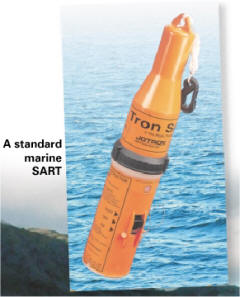
A SART transmission is triggered by a signal sent out by radar of a search vessel and shows up on the screen as a series of dots, accurately indicating the position of the SART. SARTs are packaged in approved life rafts for fishing vessels greater than 20 metres to serve as standard detection equipment. They are sometimes carried as optional equipment on fishing vessels less than 20 metres. SARTs are mandatory equipment for 'Safety of Life at Sea' (SOLAS) class vessels and are mounted on the bridge ready for manual transport in the event of an emergency evacuation. They offer an excellent detection device in the event of a distress situation.
Fish harvesters using SARTs should be aware of the following operating procedures:
- SARTs should be properly maintained and operated according to manufacturer's standards;
- in the event that a vessel must be abandoned, SARTs should be taken aboard the survival craft; and,
- SARTs must be manually activated and placed as high as possible clear of obstructions that would impede or supress signals to and from the radar.
Radar Reflectors
Radar reflectors should be properly placed clear of obstruction and as high as possible onboard a vessel. This provides additional assurance of detection during times of poor visibility and darkness when radar searches are sometimes the only option available to SAR providers.
Visual Detection
Visual detection is ultimately the last step in the process of response before rescue or any type of assistance is provided. There are steps you can take to prepare for visual detection during an emergency situation:
- fishing vessels, whether open or closed construction, should be painted in a colour that produces maximum optical detection in the working environment;
- flares should be carried and used in a prescribed manner. Fish harvesters may need to activate a flare(s) to signal to a SAR resource when it arrives in the immediate vicinity of a distress vessel;
- work and/or protective clothing should be in colours easily seen in the marine environment; and,
- a life jacket should be worn at all times when operating in open or exposed areas on a vessel.
While survival equipment has the primary function of providing buoyancy, its colours make an excellent target for detection in the event of a rescue operation. Fish harvesters should wear protective clothing, such as rain gear, that reflects colours that are easy to detect, such as yellow or orange. Black and other dark colours blend in with surrounding environment. Similarly, fishing vessels should be a colour that will assist with detection in emergency situations. For example, a blue coloured hull in the ocean or a white coloured vessel harvesting seals in ice fields is difficult and sometimes impossible to detect by searchers.
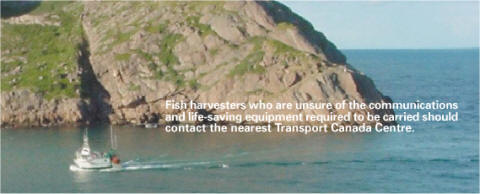
Response
Response Infrastructure
Implementation of International Conventions, International Joint Agreements and domestic legislation provide protection for all mariners who find themselves in danger at sea. It is mandatory for a vessel to respond to a distress situation and failure to do so, without just cause, has legal consequences.

The administration and/or coordination of Canada's obligation to the international SAR system is ajoint responsibility shared between the lead agency, DND and DFO - CCG.
The following systems and resources are in place to fulfil this role:
- three JRCCs located in Victoria, BC, Trenton, ON, and in Halifax, NS;
- two MRSCs located in Quebec City, Quebec and in St. John's, NL;
- a staff of maritime and aeronautical coordinators who are trained in search planning and coordination and empowered with legislative authority to issue instructions and/or direct vessels to assist mariners in distress;
- a SAR communications network, which includes a series of MCTS centres located in strategic locations across Canada for listening watch and response to emergencies at sea;
- a staff of MCTS officers who are trained to identify emergencies at sea and assist in facilitating a SAR response; and,
- a vast network of resources including police, harbour authorities, other federal and/or provincial/territorial response agencies and aircrafts and vessels that are both publicly and privately owned. To conduct SAR operations in respective areas of responsibility throughout Canada, the following resources are available to rescue coordinators at the JRCC/MRSCs:
- primary (dedicated) air resources including DND fixed-wing aircraft and helicopters that are placed in a SAR state-of-readiness;
- secondary air resources:
- DND aircraft based across the country that are not assigned to a dedicated SAR status but can be assigned to SAR duty when deemed necessary by the JRCCs
- a fleet of CCG helicopters assigned to support regional CCG programs
- CCG chartered patrol aircraft
- aircraft from the Civil Air Search and Rescue Association (CASARA)
- aircraft from foreign governments as arranged through bilateral SAR agreements.
- private industry aircraft such as offshore petroleum and mining helicopters on an opportunity basis
- privately aircraft chartered by the JRCC/MRSCs as required;
- primary (dedicated) marine resources including specialised multi-purpose inshore and offshore CCG vessels that are placed in a SAR state-of-readiness;
- Secondary marine resources:
- CCG vessels such as buoy tenders, fishery patrol and science vessels, hydrographic survey vessels and icebreakers, not normally assigned to dedicated SAR status but that can be assigned to SAR duties when deemed necessary by the JRCC/MRSCs
- other government vessels such as a network of small DFO fisheries enforcement and RCMP inshore patrol craft
- DND naval vessels
- vessels involved in ferry operations
- volunteers such as small to medium fishing vessels, pleasure craft, small commercial vessels and other private operators recruited through the Canadian Coast Guard Auxiliary (CCGA)
- private charters, as required; and,
- Vessels of opportunity.
SAR Resources
The use of SAR resources involves many considerations relating to the level of the emergency unfolding at any given time. Primary SAR vessels and aircraft are specifically designed, equipped and crewed for SAR purposes. These resources are strategically located and positioned in areas where activity is highest. A pre-determined response capability makes these resources available the moment an alert is received.

SAR Expertise
Highly trained SAR technicians, with medical and rescue expertise, are available on air resources. CCG vessels carry Rescue Specialists (RS) who have training in pre-hospital emergency care and other types of rescue techniques. Efforts also go towards equipping and training voluntary organizations such as the CCGA and CASARA.
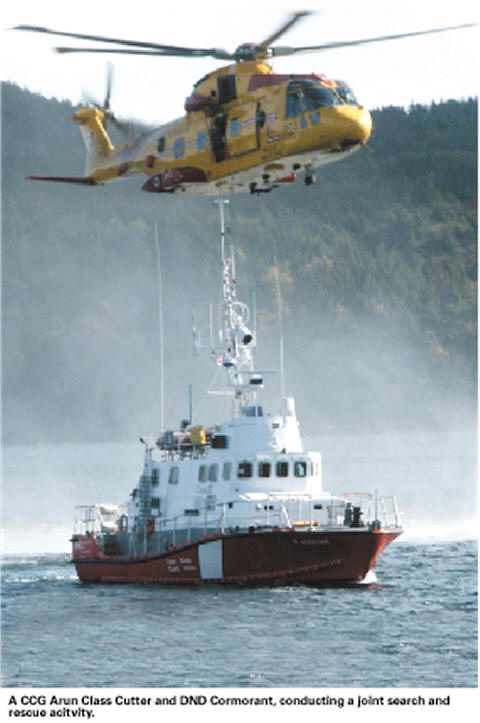
JRCC/MRSCs
The rescue coordinator at each JRCC/MRSC assesses all alert situations for an appropriate response. All SAR operations, including search planning, resource tasking and rescue coordination are conducted under the authority of the rescue coordinator who assumes the role of the Search Mission Coordinator (SMC). The JRCC or MRSC that will be assuming SMC responsibilities will be determined by the area of responsibility assigned to that centre. Fish harvesters can activate the SAR system at any level and do not have to be preoccupied with determining which centre they should alert for assistance.
Response Types
Response to alerts may come from many areas of the marine community. The type of response could range from a dedicated SAR resource to a private vessel operating a close distance to the vessel in distress. The degree of urgency, the type of emergency, the availability of resources, and the location are all key elements that determine the type of response in a given situation. Some of the most common alerts received from fish harvesters are:
- vessels taking on water, on fire, or running aground and with hull damage;
- medical emergencies;
- person in the water;
- failure to arrive at intended destinations, return to port on time, or generally considered overdue; and,
- other urgent situations, but often preventable including disorientation, mechanical failure, steering problems, and fuel shortages.
Distress Response
Distress alerts command the highest degree of urgency in the maritime community and warrant the greatest level of response. For the most part, response to such situations is spontaneous and based on a long-standing system of tradition, conventions, agreements and moral and legal obligations. Response is often well underway before the alert is received at the JRCC/MRSC. Mariners, knowing their responsibility and having the means to carry it out, often proceed to assist in an appropriate manner. MCTS centres enhance the response with communications and traffic systems capabilities. "Mayday relay" broadcasts through the Coast Guard radio, NAVTEX broadcasts and Enhanced Group Calling (EGC) through the Inmarsat C satellite system help to broaden the response network.
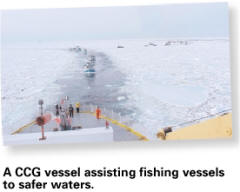
The Search Rescue Coordinator (SMC) will assess the distress situation and put in place a response action plan. All available primary and secondary resources, including air and marine, will be assessed for tasking. Vessels of opportunity will be identified using MCTS and Inmarsat monitoring systems.
The Automated Mutual Vessel Reporting System (AMVER) and other informal systems directly available to the JRCC/MRSC will be consulted for resource locations and other types of assistance such as medical expertise.
Distress situations can be highly unpredictable. A distress incident can sometimes be resolved as quickly as it started. Other times it can evolve into a complex situation. If necessary, an On Scene Coordinator (OSC) will be appointed by the SMC to assist with communications and coordination until the SAR operation has ended.
There are times when abandoning a vessel is the only option for a successful rescue. Fish harvesters must be aware that when searchers are required to locate a person in the water or life rafts, there are tools available to assist searchers, including night vision goggles (NVGs), datum marker buoys (DMBs) and computer aided search panning. The best insurance for a successful response lies directly with fish harvesters themselves in making sure they are prepared for easy detection and good protection from the elements.
Person in the Water
A man overboard alert is treated with the same response system as a distress alert. An urgency or " Pan" broadcast by MCTS centres and the INMARSAT system broadens the response network and clears emergency channels for coordination. Immediate alerting is an essential element of response in the case of a man overboard, since probability of detection and survival is substantially reduced with the passage of time.
Non-Distress Incidents
Marine incidents are not always life threatening. Each one has to be treated differently, as there is always the potential that it may evolve into a life-threatening situation. Each situation is subject to the judgement of the rescue coordinator. If assistance is required, the following options will be considered:
- ensure that every attempt has been made by the vessel to arrange commercial assistance;
- assist the disabled vessel in arranging commercial assistance;
- if no commercial assistance is available and/or it is determined that an incident is about to develop into a distress situation, a SAR resource will be tasked to assist;
- if towing assistance is required, the vessel will be towed to the nearest safe haven and released in accordance with the national SAR towing policy; and,
- if a vessel is disabled due to a fuel shortage and is unable to arrange commercial assistance, sufficient fuel or a tow may be arranged to allow the vessel safe passage to the nearest safe haven.
Medical Emergencies
Medical expertise does not exist at the JRCC/MRSC but it can be accessed quickly and efficiently through the SAR communications network. When a medical emergency occurs, MCTS can conduct a radio medical with fish harvesters and medical authorities. Once medical requirements are identified the SMC will consult with medical authorities to determine a course of action. Depending on the circumstances, the response could entail:
- remedial action onboard the vessel based on instructions from medical authorities;
- tasking a private vessel of opportunity that has medical expertise or other capabilities onboard;
- evacuation by the quickest possible means including aircraft or marine resources;
- placing advanced First Aid experts such as DND SAR Technicians (SARTECHs) and/or CCG Rescue Specialists (RS) onboard; and,
- facilitating an expeditious transit to the nearest medical facility by providing escort, advice and/or arranging ambulances.
Overdue Vessels
Overdue vessels trigger a very comprehensive SAR operation, involving the entire communications network, urgency broadcasts, air and marine resource tasking and police and harbour authorities.
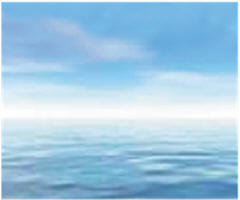
Overdue situations are often very difficult to resolve by SAR authorities, mainly because of time and lack of information. Fish harvesters must be fully aware that they are the ones most essential in providing necessary information. The use of sail or float plans must contain elements of time, location and descriptions involving the vessel and people on board (POB). Likewise, people or organizations responsible for the implementation of sail plans must understand their role in administrating the plan on behalf of fish harvesters. Their role in alerting the SAR system should be in keeping with the following criteria:
- failure to return on time as indicated in the plan;
- in the absence of a stated arrival time, failure to arrive as per normal routine;
- adverse circumstances such as weather, sea or ice conditions that may have inhibited a safe transit;
- a report received from other sources that raises concerns for the safety of the vessel in question; and,
- other safety concerns that may not have been known to the vessel in question such as developing weather systems.
Once aware of an overdue situation, coordinators at the JRCC/MRSC will verify information and conduct an immediate communications search. Failing contact with the vessel in question, a search plan will be established and tasking of resources will occur. A search activated for overdue situations will continue until the safety of the people on-board is assured or until all reasonable efforts are exhausted and certainty has been established that survival is no longer possible.
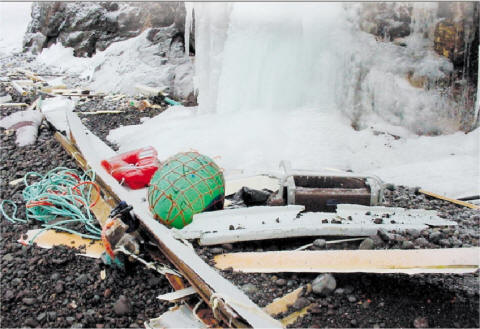
Early Alerting
At all times response mechanisms work best when emergencies or pending emergencies are reported early. Attempting to repair equipment failures is correct, but notifying the SAR system via MCTS centres or other appropriate agencies should be done before the situation gets worse. Second party involvement is also an acceptable practice, but in order to avoid errors or misunderstandings, direct communication with a shore station is preferred if at all possible. Fish harvesters are encouraged to communicate their emergency radio priorities using the MAYDAY, PAN or SECURITE prefixes during appropriate levels of emergencies. These priorities are used in the following manner:
- MAYDAY (repeated three times) to announce a distress situation whereby fish harvesters are threatened by grave and imminent danger and requires immediate assistance;
- PAN PAN (repeated three times) to announce an urgency situation whereby fish harvesters intend to transmit an urgent message concerning the safety of their vessel or a person onboard or within sight of their vessel; and,
- SECURITE (repeated three times) to announce a notice concerning the safety of navigation or meteorological warnings.


Information pertaining to the use of the radio priorities is outlined in the annual RAMN publication under the Distress, Urgency and Safety communications sections.

Self Help System
While a comprehensive SAR system is designed to provide protection for the user, fish harvesters must remember they are responsible for their own safety. The SAR system works best when the users equip themselves for maximum survivability. Compliance with the elements outlined in alerting, detection and response provides a good measure of insurance in the event of a marine emergency.

Fish harvesters, in equipping their vessel for their own safety, should consider prevention and preparedness and exercise it in the following manner:
- develop a proper contingency plan to deal with emergency situations;
- ensure all crew members are aware of their role in a contingency plan and are properly trained to execute it effectively when an emergency occurs;
- build a reliable network of local and/or community support, including a buddy system when conducting fishing activities;
- make safety a family issue and provide the family with the means, especially as it relates to information and communication, of assisting in a response situation;
- acquire knowledge through education and awareness by participating in training programs pertinent to relevant activities;
- understand the elements of Marine Emergencies Duties (MED) through the acquisition of proper training and exercising it accordingly;
- equip fishing vessels with the proper level of safety and survival equipment; and,
- develop a regime of safe practices at all times when engaged in fish harvesting activities.
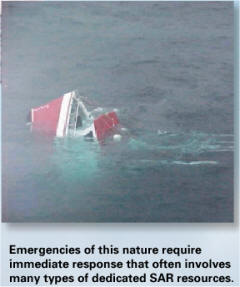

The importance of training in preventing fishing vessel accidents and having the capacity to deal effectively with accidents when they occur cannot be overstated. Recent efforts have focused on delivering preventive education and MED training for all levels of fish harvesters across Canada. Current Transport Canada (TC) regulations require a minimum standard of training in MED for all crew and operators of small fishing vessels less than 150 gross tons. To apply the most suitable training to fish harvesters the following guidelines have been established by Transport Canada (TC):
- MED A1 is required for crewmembers fishing more than 20 N/M offshore;
- MED A3 will be allowed in lieu of MED A1 for crewmembers on fishing vessels operating not more than 20 N/M offshore; and,
- MED A4 will be allowed in lieu of MED A1 for crewmembers on board fishing and aquaculture vessels operating in sheltered waters not more than two N/M from shore.

Due to lack of delivery and training programs, the deadline for completion of MED courses was extended from July 31, 2002 to April 1, 2007. In order to meet this new deadline, all fish harvesters are required to register for the requisite course. Enforcement action will be taken under the Canada Shipping Act against any fish harvester that fails to demonstrate proof of registration by July 31, 2003. Full enforcement action will be taken if training is not taken by April 1, 2007.
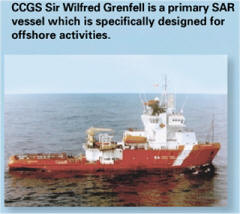
Fish harvesters should contact the nearest Transport Canada Centre or course providers at marine training institution across Canada for details regarding course requirements.

Internet Sites
Fisheries and Oceans Canada | www.dfo-mpo.gc.ca
Canadian Coast Guard | www.ccg-gcc.gc.ca
National SAR Secretariat | www.nss.gc.ca
Transportation Safety Board of Canada | www.tsb.gc.ca
Transport Canada | www.tc.gc.ca
Industry Canada | www.ic.gc.ca
Acronyms
- AMVER
Published and produced by:
Fisheries and Oceans Canada
Communications Branch
P.O. Box 5667
St. John’s NL A1C 5X1Telephone: 709-772-7623
Fax: 709-772-4880
with assistance from
Transport Canada
Canadian Coast Guard Internet Site | www.ccg-gcc.gc.ca
Transport Canada Internet Site | www.tc.gc.ca
Catalogue - T31-123/2003E | ISBN - 0-662-34087-6
Disponible en fran�ais
|

